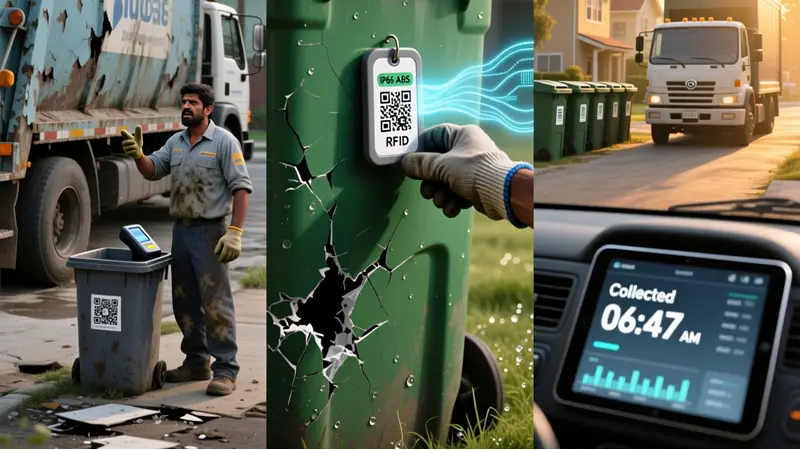
Manesar’s RFID Waste Project: A Second Chance – Done Right This Time
Custom Your RFID Cards
Recently, the Municipal Corporation of Manesar (MCM) in India’s Gurgaon region announced a major initiative. It will install RFID tags in all residential areas and commercial businesses. The goal is to reform its waste collection system. On the surface, it’s a local public works upgrade. But for city planners, tech vendors, and smart-city watchers, it’s something more: a real-world stress test of how RFID can tackle the kind of gritty, high-friction urban challenges that simpler tech often fails to solve.
The Old Way: Guesswork, Gaps, and Growing Complaints
To understand the need for RFID, we must first understand what is wrong with traditional waste management. For a long time, Manesar and many cities worldwide have faced the same problems:
- Lack of Monitoring: Did the truck arrive at every home on time? Were any streets missed? The system relied on manual reports, so data was not transparent.
- Unclear Responsibility: Residents complained about missed garbage, but contractors insisted it was collected. Without data, the municipal department could not enforce accountability.
- Low Efficiency: Collection routes were based on experience, not optimized with real time data.
- Backlog of Complaints: In Manesar, from January to October 2025, 104 sanitation complaints on the Swachh City portal remained pending. (source)
The core of these issues is the lack of reliable, automated data. This is the key strength of RFID technology.
Why RFID? Because Trash Bins Aren’t Office Desks
Why did the municipal corporation not use cheaper barcodes or QR codes? As RFID professionals, we know waste management is a difficult test for technology. It is not like an office. RFID, by contrast, thrives where other identifiers falter:
- Built for the real world: RFID Tags sealed in ABS plastic or ruggedized polymer shrug off moisture, dust, UV exposure, and impacts. They’re not designed to look pretty, they’re designed to last.
- Speed without stopping: Unlike QR codes which require a worker to stop, aim, and scan RFID readers (mounted on trucks or handheld units) capture tag IDs automatically, from several feet away, even at low speeds. No dismounting. No fumbling. Just drive by, collect, and log.
- Unforgeable accountability: Every RFID tag carries a unique, factory-assigned ID tied to a specific address. When a truck passes, the system logs who, when, and where, creating a tamper-resistant digital receipt. That data becomes the basis for everything: performance reviews, contractor payments, route adjustments, even resident billing in pay-as-you-throw models.
In short, RFID doesn’t just add data, it replaces doubt with evidence.
Not a Smooth Path: Learning from Gurugram’s 2022 Failure
The RFID technology itself is mature. But the project’s “implementation model” is just as important. Manesar’s neighbor, the Gurugram Municipal Corporation (MCG), tried a similar RFID project in 2022. It ultimately failed. (source) From a technical review, the key reason for Gurugram’s (MCG) failure was not the RFID technology itself. It was disastrous project management:
- MCG subcontracted the project to two different agencies. Agency A was responsible for installing RFID tags and the system. Agency B (the waste collection contractor, Ecogreen) was responsible for daily waste collection.
- As a result, Agency B’s drivers (Ecogreen) refused to use Agency A’s scanning devices. They stated that RFID scanning was “not included in their scope of work”.
- Because the two key parts could not work together, the entire RFID system (including 200,000 installed tags and a control room) stalled. It became “zombie technology”.
Manesar’s New Strategy: An Integrated Responsibility Model
Fortunately, Manesar (MCM) clearly learned from Gurugram’s lesson. In its 2025 new project, MCM used a smarter contract strategy: an “integrated responsibility” model. Through a tender, they gave the entire job of waste collection, transport, and RFID tag installation and operation to one single private agency (Pooja Consultation Service). This was a smart move. It solved Gurugram’s “blame game” problem:
- The contractor’s main income comes from waste collection service fees.
- The municipal company (MCM) pays these fees only on the “collection complete” data from the RFID system.
Under this model, the contractor’s motivation to use RFID changes. It is no longer an “extra burden.” It is now a “proof of payment.” The interests of technology (RFID) and operations (waste collection) are tied together. This helps ensure the project runs smoothly.
Conclusion: RFID is the Foundation for Building Smart Cities
The Manesar project (regardless of its final outcome) is a clear signal: Modern urban management is shifting from “based on experience” to “based on data”. Waste management is just the beginning. RFID technology provides bulk, automatic, and reliable identification. This makes it a necessary foundation for smart cities. From smart inventory and supply chain logistics to asset management and urban sanitation, RFID plays a central role. RFID is not just a tag. It is a powerful tool for achieving transparency, accountability, and efficient operations.


